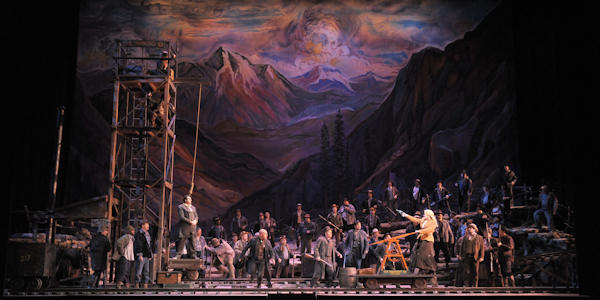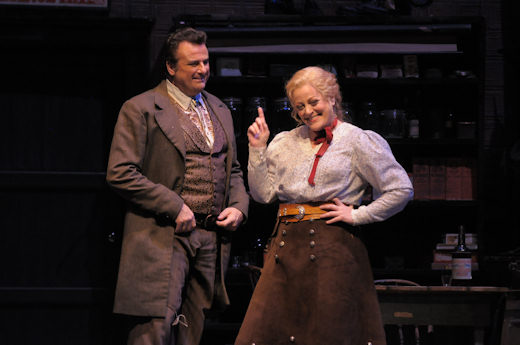Other Links
Editorial Board
- UK Editors
- Roger Jones and John Quinn
Editors for The Americas - Bruce Hodges and Jonathan Spencer Jones
European Editors - Bettina Mara and Jens F Laurson
Consulting Editor - Bill Kenny
Assistant Webmaster -Stan Metzger
Founder - Len Mullenger
Google Site Search
SEEN AND HEARD INTERNATIONAL OPERA REVIEW
Puccini, The Girl of the Golden West: Soloists, Chorus and Orchestra of Lyric Opera of Chicago, Sir Andrew Davis (conductor) Civic Opera House, Chicago, 22.1.2011 (JLZ)
Production:
Stage Director: Vincent Liotta
Original Production: Harold Prince
Original Set Designer: Eugene Lee
Original Costume Designer: Franne Lee
New Scenery and Costumes: Scott Marr
Lighting Designer: Jason Brown
Chorus Master: Donald Nally
Conductor: Sir Andrew Davis
Cast:
Handsome: Paul La Rosa
Harry: René Barbrea
Joe: James Kryshak
Happy: Paul Scholten
Nick: David Cangelosi
Sid: Philip Kraus
Sonoa: Daniel Sutin
Trin: David Portillo
Jim Larkens: Corey Crider
Jake Wallace: Paul Corona
Jack Rance: Marco Vratogna
Ashby: Craig Irvin
Minnie: Deborah Voigt
Pony Express Rider: Javier Bernardo
Ramerrez (Dick Johnson): Marcello Giordani
José Castro: Sam Handley
Wowkle: Katherine Lerner
Billy Jackrabbit: Evan Boyer
At its centenary, Puccini's 1910 opera
La fanciulla del West has been offered by several companies, and this season Lyric Opera of Chicago revived its 1978 production, which involved Hal Prince. (His production of the composer's
For this revival Lyric features two principals who are known for their Fanciulla performances: Deborah Voigt as Minnie and Marcello Giordani as the bandit Ramerrez (whom Minnie loves as Dick Johnson). But the production provided ample opportunities for other fine singers as well, and the Lyric’s Chorus; in the atmospheric first act, the men were highly effective, with clear diction and fine intonation. Not only did they create a solid foundation, but they gave the audience the chance to hear some current and past members of the company’s noted Ryan Opera Center program.

The Act III Set - Picture © Dan Rest

Marcello
Giordani and Deborah Voigt - Picture © Dan Rest
As Nick the bartender, David Cangelosi anchored the scene, and his continuous movement was a welcome addition to the sometimes static imagery. As the plot advanced (that is, the search for the bandit Ramerrez) the exchanges were sometime difficult to hear, particularly the interactions between the sheriff, Jack Rance, sung by Marco Vratogna, and the Wells Fargo agent Ashby, portrayed by Craig Irvin. Yet Deborah Voigt's entrance—with her firing of a pistol—immediately shifted the action to the rivalry for the hand of her character, Minnie. Here Vratogna conveyed a Scarpia-like longing ("Minnie, dalla mia casa"), which Voigt counterbalanced with her response in "Laggiù nel Soledad." Vratogna sometimes emphasized the parlando delivery, which gave a sense of the text, but occasionally at the expense of the line. At times in the first act Voigt's pitches were compromised by the orchestra, with some straining also evident in the tutti passages. When Marcello Giordani made his entrance as Ramerrez, he immediately commanded attention with his stage presence and powerful voice. Sometimes his volume was out of balance, which could be attributed to the blocking, but this is a role he does well.
In the second act (the meeting between Ramerrez and Minnie at her cabin, where Rance eventually apprehends Ramerrez), the principals sounded more at ease. Voigt made her arietta "Oh, se sapeste" convey her character's situation with appropriate emotion. The rapport between Voigt and Giordani added to the overall effect, effectively setting up the threatening nature of Rance's character. In the third act, when Rance ultimately captures Rammerez and Minnie saves him, the chorus completed the scene with a vivid reading.
Modern audiences will notice Andrew Lloyd Webber borrowed an idea from Fanciulla for his musical Phantom of the Opera for "The Music of the Night." The dramaturgy bears similarities, too, drawing on the popular Western, the saloon girl with a heart of gold, the bandit who wants to reform, and the sheriff whose commitment to justice becomes an obsession worthy of Melville's Captain Ahab. At the same time some stereotypes are evident in this production, such as the costuming and position of Minnie's servant Wowkle (played by Katherine Lerner) as a 1950s television Indian, with papoose and wigwam, elements that may benefit from reconsideration. On the other hand, other ideas are charming, like Minnie’s entrance as a dea ex machina on a railroad car in lieu of a horse.
However, the volume of the orchestra sometimes intruded on the voices, including both the leading soloists and, from time to time, the chorus. It is good to hear the score played with such enthusiasm, but the challenge is to allow it to illuminate the text, which was sometimes compromised by the acoustics. The playing was nonetheless fine, with good pacing on the part of the conductor, Sir Andrew Davis.
James L. Zychowicz
